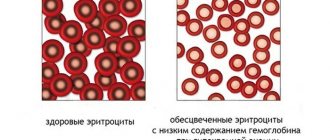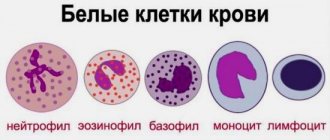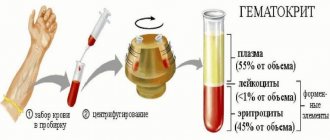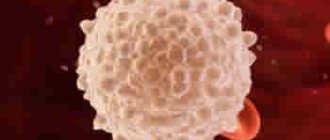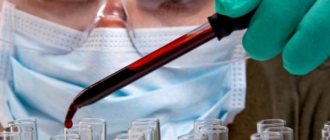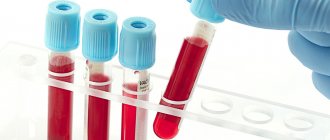0
Author of the article: Marina Dmitrievna
2017.09.29
3 306
Blood analysis
Anisochromia in a general blood test can occur in all patients, regardless of gender and age. The very concept of anisochromy determines the heterogeneity of the color of the resulting biomaterial.
When examining blood serum, this term refers to uneven, insufficiently pigmented or, conversely, excessively bright blood color.
One of the reasons for this deviation is a change in the concentration of hemoglobin in red blood cells. Most often, this is provoked by some kind of pathological process or is regarded as an acceptable response of the body to a stimulus.
General definition
Anisochromia in a general blood test is a condition in which there is uneven coloration of red blood cells. This is due to the hemoglobin content in them. The more of it there is in red blood cells, the brighter their color. Those red blood cells that contain insufficient hemoglobin look paler. In a blood test, this indicator is determined as color.
The main function of red blood cells is to transport oxygen from the lungs to the body tissues. The more hemoglobin these blood cells contain, the faster the body is saturated with oxygen. But there must be moderation in everything. Therefore, experts have identified the optimal hemoglobin content in red blood cells, which allows for the most efficient functioning of the entire body. Deviation from normal values may indicate the presence of pathological processes.
Varieties
The condition of hypochromia is divided into several different types of anemia that can be experienced by patients.
Iron-deficiency anemia
Anemia with iron deficiency is the most common type of all; its causes are bleeding, low intake of iron elements (especially insufficient consumption of meat products) with difficulty absorbing this element. Often observed during pregnancy and breastfeeding, young women are also susceptible.
Sideroblastic anemia
This species is characterized by a normal level of iron in the blood, but its absorption into the blood is impaired, and this reduces the number of hemoglobin cells included in the general blood test. Elderly people suffering from alcohol addiction, poisoning with substances of chemical origin, or long-term drug therapy are prone to this type.
Important information: What is platelet aggregation in the blood (analysis transcript)
Ferro redistribution anemia
With Ferro redistribution anemia, an increase in the number of iron-containing elements is observed, with the death of the red blood cells themselves. Occurs against the background of tuberculosis of the lungs, diseases with a purulent course.
Mixed anemia develops with a lack of B vitamins 12 and iron compounds; its signs are:
- increased fatigue;
- decrease in the body's immune forces;
- frequent swelling in the upper extremities.
Norm
Normal hemoglobin levels in red blood cells depend on a person’s gender and age. Below is a table of normal values.
| Gender/age | Norm, 1012/l |
| Men | 3,9-5,3 |
| Women | 3,6-4,7 |
| Children | 3,8-4,9 |
Causes of anisochromia in a general blood test, its types
When examining blood serum, this term refers to uneven, insufficiently pigmented or, conversely, excessively bright blood color.
One of the reasons for this deviation is a change in the concentration of hemoglobin in red blood cells. Most often, this is provoked by some kind of pathological process or is regarded as an acceptable response of the body to a stimulus.
https://www.youtube.com/watch?v=o94ikVJc6L0
An erythrocyte is a biconcave elastic postcellular structure of blood measuring 6-11 microns, containing hemoglobin. It is produced by the bone marrow of the ribs, skull and spine. The duration of connection functionality varies within a day.
Due to its specific concavity, the red blood cell has a large surface area. This has a positive effect on the structure of the formation, since it becomes elastic and mobile, performs its main functions faster and easily penetrates the smallest capillaries.
Its size is influenced by a person’s gender: male red blood cells are smaller in size than female ones. Its volumes also depend on the water content in the body - with an increase in osmotic pressure, the size of the cells decreases and vice versa.
The redness of the cells depends on the number of hemoglobin molecules. The main task of this substance is to transport oxygen throughout the human body.
Hemoglobin contains iron atoms, which attach oxygen and prevent it from leaving. Red blood cells are enriched with it in the lungs, then, with the help of blood circulation, they are distributed throughout the body. The higher the concentration of hemoglobin in them, the faster they work and deliver oxygen.
Kinds
Anisochromia in a general blood test can manifest itself in the form of normochromia, hypochromia and hyperchromia. Let's consider these phenomena in more detail:
1. Normochromia is a normal state in which red blood cells are uniformly pink in color with a small spot of light color in the middle.
2. Hypochromia - a decrease in the level of hemoglobin in red blood cells. In this case, there is a disruption in the delivery of oxygen to the tissues, which leads to hypoxia of the organs. As a rule, anisochromia in a general blood test of this type indicates anemia. Currently, experts distinguish three degrees of hypochromia:
- The middle part of the blood cell is significantly lighter than normal.
- Only the periphery of the erythrocyte is colored red.
- The red blood cell remains light, only redness of the cell membrane is observed.
3. Hyperchromia. This type of blood anisochromia indicates oversaturation of red blood cells with hemoglobin. The blood cell has a bright red color without clearing in the middle. The red blood cell itself is increased in size. This condition is quite dangerous, as it can lead to the development of dangerous conditions due to the fact that cells become unable to perform their transport function.
What is hyperchromic anemia?
Hyperchromic anemia is a disease accompanied by an increase in the color index of the blood, while the amount of hemoglobin in the blood decreases. CBC - a general analysis of blood and red blood cells, allows us to identify this pathological condition.
Read also Thalassemia. Causes, symptoms and treatment of the disease
Anemia with hyperchromia of the formed elements is accompanied by typical anemic symptoms, as well as some neurological problems - sensitivity is reduced, mucous membranes are affected.
The disease develops against the background of a disruption in the production of normal DNA due to a lack of folic acid. This leads to a decrease in the rate of hematopoiesis and the appearance of large red blood cells.
Causes of the condition
Anisochromia can normally be present in an absolutely healthy person, but the percentage of unevenly colored cells is so small that they are practically not detected by a blood test.
The causes of anisochromia in a general blood test will be discussed below.
Hypochromia
The reasons are the following:
- Anemia. This is the main reason for the development of this condition. They can be of several types: iron deficiency, iron-saturated (in the body the concentration of iron is within normal limits, but under the influence of certain factors it is poorly absorbed by cells) and iron redistribution (develops when red blood cells are destroyed under the influence of various pathological processes).
- Bleeding.
- Pregnancy and adolescence.
- Diseases of the gastrointestinal tract.
- Chronic diseases (for example, bronchitis or heart disease).
- Chronic purulent inflammatory processes occurring in the body.
- Poor nutrition with lack of protein.
- Taking certain medications.
- Poisoning.
Hyperchromia
The reasons for detecting anisochromia in a general blood test, which is defined as hyperchromic, are the following conditions:
- Deficiency of vitamin B12 and folic acid.
- Intestinal diseases.
- Congenital diseases.
- Hereditary factor.
- Malignant tumors of the stomach or lungs.
- Hepatitis.
- Presence of worms.
- Blood diseases.
- Pathological conditions of the kidneys.
- Consequences of radiation or chemotherapy used in the treatment of leukemia.
- Disturbances in the normal functioning of the bone marrow.
Qualitative and quantitative analysis
Counting the number of red blood cells performed using a hematology analyzer is not very informative. To obtain complete information, morphological or qualitative analysis is used.
What this research allows you to do:
- Examine the smear;
- Determine the size of red blood cells;
- Visually see the degree of saturation of red blood cells with hemoglobin.
Morphological signs of hypochromic anemia:
- Hypochromia;
- Hypochromia and microcytosis;
- The appearance of schizocytes (fragments of red blood cells) and normoblasts (young cells);
- Polychromatophilia is a condition when the smear contains red blood cells that can be stained with acidic and alkaline dyes;
- Fluctuations or lack of response from the white blood.
Symptoms
Before anisochromia is detected in a general blood test, a person may notice symptoms that indicate the development of this pathological condition. These include:
- Fast fatiguability.
- Decreased concentration.
- Prostration.
- Mood swings.
- Dizziness.
- Rapid heartbeat for no apparent reason.
- Dyspnea.
- Headache.
- Noise in ears.
- Paleness of the skin.
- Sleep disorders.
- Increased skin sensitivity.
- Hair loss.
- Numbness of the limbs.
- Loss of smell and taste.
If the above symptoms appear, it is recommended to consult a doctor as soon as possible and undergo the necessary tests.
Anisochromia in children
Diagnosing anisochromia in a general blood test in children in most cases indicates the development of anemia. This is a fairly common pathology in childhood, which occurs due to intensive growth of the body against the background of an underdeveloped hematopoietic system. This can also be contributed to by poor nutrition and various pathological processes occurring in the body.
Manifestations of pathology include pale skin, some developmental delay, lethargy, apathy, the appearance of cracks in the corners of the lips, prolonged and frequent colds.
Parents should monitor their children more closely and consult a doctor at the first suspicious signs.
Why does it occur
Hypochromic anemia can occur for many reasons:
- Loss of blood volume, leading to bleeding, during long and heavy menstruation, during surgical interventions as a result of injury.
- With poor nutrition, this is due to a deficiency of vitamin and mineral complexes in the body, often observed in vegetarians and those on a strict diet.
- Internal bleeding of a hidden nature, often occurring or constant, the patient simply may not see this situation, the cause may be inflamed gums, hemorrhoids and other diseases of the intestines, gastrointestinal tract, and female organs of the reproductive system.
- Chronic infectious diseases, such as pulmonary tuberculosis, various types of hepatitis, in this case, iron elements are poorly distributed and enter organs and tissues.
- When the body is intoxicated with substances of chemical origin.
- The risk of anemia is associated with pregnancy, since during this time the female body needs several times more iron.
- Helminthic infestations.
- Autoimmune lesions of the body.
Hypochromia of erythrocytes in children often occurs in premature infants, due to a conflict of the Rh factor, intrauterine transmission of infections to the mother, unbalanced nutrition during gestation, or birth injury. During adolescence, most adolescents are susceptible to anemia; this is due to hormonal changes and an increased period of growth.
Important information: What does a reduced (below normal) hematocrit in a child’s blood mean?
Diagnostics
Anisochromia is detected using a general blood test, which pays special attention to the level of red blood cells and hemoglobin. To identify the cause of deviations in indicators, the following laboratory and instrumental examinations may be prescribed:
- Analysis of urine.
- Fecal occult blood test.
- Ultrasound examination of the kidneys.
- Fluorography.
- Blood serum examination for iron content.
- Gynecological examination.
- Bone marrow samples.
Why is hypochromia dangerous?
Undoubtedly, hypochromia does not go away without a trace. With a prolonged course of hypochromic anemia, the patient may experience complications. Most often they are observed in older people. What are the consequences of hypochromia? This is an increase in the size of the liver, a change in the size of the spleen, swelling, many patients experience numbness in the limbs, problems with the functions of the cardiovascular system.
Hypochromia is extremely dangerous for pregnant women, as the fetus may develop oxygen starvation. This condition is pathological, as it can even cause fetal loss. That is why it is highly not recommended to take risks. Doctors advise taking a clinical blood test at least once a year. This will help prevent the development of various diseases and pathologies.
Is hypochromia treatable? If the disease is detected at an early stage of development, the chances of successful recovery are high.
However, treatment does not occur quickly; a long recovery time is required. The treatment itself depends on the cause. If a patient has low iron levels, the doctor will prescribe iron supplements. It is also necessary to consume foods high in this substance. The medications can be prescribed either in tablets or intravenously.
Possible treatment
If anisochromia is detected in a blood test, treatment is aimed at eliminating the root cause and relieving unpleasant symptoms. In most cases, complex therapy is prescribed, which includes medication, adherence to a certain diet and the use of traditional medicine. It is worth noting that if anisochromia is detected in a general blood test, therapy is prescribed only by the attending physician. Self-medication can lead to aggravation of the situation and provoke the development of more serious diseases. Let's look at the most common treatment methods.
Medication
In most cases, the following is prescribed:
- Iron preparations (for example, Ferrum-Lek, Hemofer, Ferrofolgama and others). When a drug is prescribed in the form of a dropper or injection, treatment is carried out in a hospital setting.
- Vitamin B12. As a rule, this drug is prescribed by injection (for example, Cyanocobalamin).
- Folic acid preparations.
There are combination preparations that include both vitamin B12 and folic acid. For example, "Maltofer".
In most cases, the above drugs are prescribed in the form of capsules or tablets. In case of complicated anemia, a decision is made to undergo treatment in a hospital setting.
Diet therapy
When blood anichochromia is detected, adherence to a special diet is of great importance for normalizing the condition. Let's look at the general rules:
- Animal protein must be present in your daily diet.
- It is necessary to limit your fat intake.
- The diet should contain the required amount of foods rich in B vitamins.
- It is recommended to use fish, meat and mushroom broths.
The following products are allowed:
- Eggs.
- Cottage cheese.
- Liver (every other day or every day in small quantities).
- Brewer's yeast.
- Mushrooms.
- Red meat.
- Fish.
- Beet.
- Apples.
- Pomegranate juice (can be mixed with beet juice or diluted a little with water).
- Legumes.
- Rose hip.
- Currant.
- Pumpkin.
The following products are not recommended:
- Tea.
- Some greenery.
- Fatty foods.
- Dairy products.
- Coffee.
- Oatmeal or millet porridge.
- Alcohol.
ethnoscience
Folk remedies are used as an additional treatment to the main therapy or as a preventive measure. The following recipes have worked well:
- Brew 10 grams of nettle leaves in a glass of boiling water. Let it brew, then apply 1 tablespoon three times a day.
- Mix dried fruits with honey and take 1 tablespoon 3 times a day.
Complications
If treatment for anisochromia is not started in a timely manner or is completely absent, more serious pathological conditions may develop. These include:
- Decreased immunity.
- Enlarged liver.
- Decreased quality of life due to unpleasant manifestations of the pathological condition.
- Growth retardation in children.
- Mental and mental retardation in a child.
- Chronic anemia.
It is important to note that if the reason for the detection of anisochromia in a general blood test is tumor processes, hepatitis and other dangerous diseases, the lack of treatment can lead to the development of serious complications.
